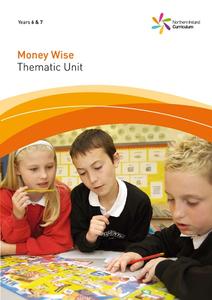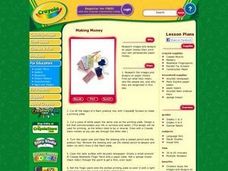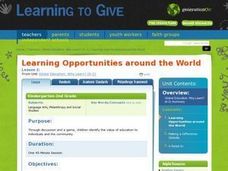Northern Ireland Curriculum
Money Wise
Does money seem to slip through your middle schoolers' fingers? Encourage them to examine spending, saving, and budgeting habits with a unit on consumer skills and money management. Young spenders study the waste that occurs with school...
Curated OER
Money: Bucks, Banks, and Business
Put economics and currency exchange rates into a real-world application kids can understand. They'll compare bus fares from various cities around the world. Each child selects three international cities to research. They determine the...
Curated OER
International Currency Exchange
Students examine coins from around the world and write down their observations. As a class, they discuss the types of symbols used on the coins from different countries and locate the country on a map. To end the lesson, they calculate...
Curated OER
Paper Money
Young scholars investigate the concept of money and its images that are found around the world. They conduct research using a variety of resources while collecting different images to create examples of money. Students create copies of...
Math Drills
Subtracting Money (A2)
Work with money math in subtraction learning exercise. With 35 subtraction problems in column format, the assignment is a good resource for review, new skills, or for assessment.
Curated OER
Money Makes the World Go Around
Students convert currency from around the world. In this math instructional activity, students solve exchange rate problems using Google Earth. They complete a worksheet during the simulation.
Curated OER
Goal! World Cup Soccer Craze and Content for the Classroom
The World Cup craze can provide many learning opportunities for students.
Curated OER
Math: Navigating the World Around Me
Young mathematicians research and discuss real world math word problems and ways in which they apply math concepts in their everyday lives. They create a storyboard of a math word problem from which they create a slide for a multi-media...
Curated OER
Learning Opportunities around the World
Students discover how education effects them and their community in a positive way. In this community lesson, students engage in a class discussion about the benefits of public education and play "community I-Spy."
Curated OER
The History of Money
In this social studies worksheet, young scholars investigate the history of paper money and coins. Students read paragraphs about what early people used for money and what kinds of banks were used. Young scholars complete a crossword...
Curated OER
Understanding the Effects of Currency Exchange Rates
In this algebra worksheet, students match the currency with the country of origin. They convert between that currency and the US using a foreign exchange conversion table. There are 35 questions.
Curated OER
All About Money Curriculum
Learners participate in different pre-lessons to examine the role of individuals and neighborhoods. They also discover the role of the IMF and nations around the world.
Curated OER
Physical Education Unit Plan: Soccer - Lesson 9
By the ninth lesson in this soccer unit, learners have studied this sport from many angles. Here they consider the right to play. Take a look at how much money professional athletes earn. Is there a difference between how much men make...
Yummy Math
Sweethearts Candy
Sweethearts® candies are a beloved Valentine's Day treat—so much so that eight billion hearts are produced every year around the world! Learners use number sense reasoning and critical thinking to solve nine word problems about the...
Curated OER
Cultures Around the World
Students research, using the Internet, cultures of the world. They identify countries, their currency, holidays, climate and societal information. They look at the distance of international cities from their hometown.
Curated OER
Drinking Water Around the World
Students explore the concept of water quality. In this drinking water instructional activity, students discuss the quality of water around the world, conduct research about drinking water, and then write essays about water quality.
Curated OER
One Dollar Around the World
Twelfth graders collaborate via ePals with another student from another country. They compare the value of a dollar with its power of acquisition in other countries. They list one dollar items and find the corresponding price in other...
Curated OER
What Makes The Good Life
What makes a good life? What makes life hard? Get your class thinking about the global picture with this extensive packet. They read quotes from around the world, analyze statistical data from every continent, then read and answer...
Curated OER
World Currencies
In this economics worksheet, students find the words that are related to world currencies. The answers are found at the bottom of the page.
Curated OER
Currency and Exchange Rates
Fifth graders share the book, "The Story of Money" and discuss the uses of money, bartering, trade and the history of money. Students discuss various ways of spending: cash, check, debit/credit cards and review the check writing process....
Curated OER
The IMF, Money, International Trade and Cooperation
Young scholars study the role of the International Money Fund and develop an understanding of international trade. They investigate learning in a cooperative atmosphere.
Curated OER
The Role of Money
Students investigate the role of money and how it is used in the world. The purpose and the history of it is covered while they look at concepts like spending in different parts of the world. This is when students practice with exchange...
Curated OER
Understanding the Effects of Currency Exchangerates
Students examine the economic effects of a strong and weak U.S. dollar. They identify the currency used in countries which regularly trade with the U.S., discuss the pros and cons of a strong U.S. dollar, and calculate the prices in...
Curated OER
Family Letter - Foreign Currency and Exchange Rates: Proportions and Ratios
In this proportions and ratios worksheet, middle schoolers solve 6 short answer problems. Students find the foreign currency exchange rates for six countries. Middle schoolers express the exchange rate as a proportion or ratio.

























